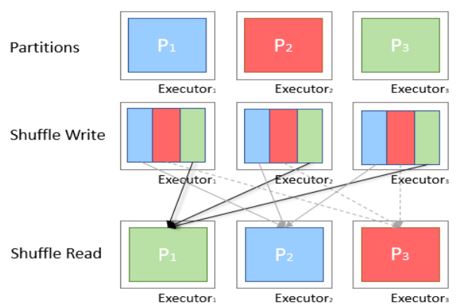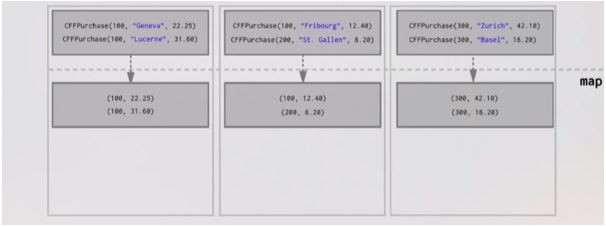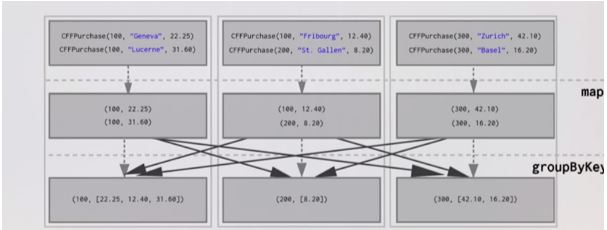How To Set Spark Sql Shuffle Partitions

Introduction to Spark Shuffle
In Apache Spark, Spark Shuffle describes the procedure in betwixt reduce task and map job. Shuffling refers to the shuffle of data given. This operation is considered the costliest. Parallelising effectively of the spark shuffle operation gives performance output as adept for spark jobs. Spark data frames are the partitions of Shuffle operations. The original data frame partitions differ with the number of data frame partitions. The data moving from one partition to the other partition procedure in order to mat upwards, aggregate, join, or spread out in other means is called a shuffle.
Syntax
The syntax for Shuffle in Spark Architecture:
rdd.flatMap { line => line.split(' ') }.map((_, ane)).reduceByKey((10, y) => 10 + y).collect()
Explanation: This is a Shuffle spark method of sectionalisation in FlatMap operation RDD where we create an application of word count where each give-and-take separated into a tuple and and then gets aggregated to consequence.
How Spark Architecture Shuffle Works

Information is returned to disk and is transferred all across the network during a shuffle. The shuffle functioning number reduction is to be done or consequently reduce the amount of data beingness shuffled.
Past default, Spark shuffle operation uses partitioning of hash to determine which key-value pair shall be sent to which machine.
More shufflings in numbers are not always bad. Retentivity constraints and other impossibilities can exist overcome by shuffling.
In RDD, the below are a few operations and examples of shuffle:
– subtractByKey
– groupBy
– foldByKey
– reduceByKey
– aggregateByKey
– transformations of a join of any blazon
– distinct
– cogroup
These to a higher place Shuffle operations congenital in a hash tabular array perform the group within each job. This is often huge or large. This can be fixed by increasing the parallelism level and the input task is so set to small.
These are a few series in Spark shuffle performance –
One partition – One executor – I core
Four partitions – One executor – Four cadre
Two partitioning – Ii executor – 2 core
Skewed keys.
Examples to Implement Spark Shuffle
Let the states look into an example:
Case #ane
( customerId: Int, destination: Cord, toll: Double) example course CFFPurchase
Let us sat that we consist of an RDD of user purchase manual of mobile application CFF's which has been made in the past one month.
Val purchasesRdd: RDD[CFFPurchase] = sc.textFile(…)
Goal: Allow us calculate how much money has been spent past each private person and see how many trips he has made in a calendar month.
Lawmaking:
val buyRDD: RDD[ADD_Purchase] = sc.textFile()
// Render an array - Array[(Int, (Int, Double))] // Pair of RDD
//group Past Key returns RDD [(K, iterable[V])] val purchasesForAmonth = buyRDD.map( a=> (a.IdOfCustomer, a.cost))
.groupByKey()
.map(p=> (a._1. (a._2.size, a._2.add)))
.collect()
sample1 – sample1.txt:
val Buy = List (ADDPurchase (100, "Lucerne", 31.60))
(100, "Geneva", 22.25))
(300, "Basel", 16.20))
(200, "St. Gallen", 8.20))
(100, "Fribourg", 12.twoscore))
(300, "Zurich", 42.10))
With the information distribution given higher up, what must the cluster look similar?
Output:


Explanation: We have concrete instances of data. To create collections of values to go with each unique key-value pair we have to move fundamental-value pairs across the network. We accept to collect all the values for each key on the node that the cardinal is hosted on. In this example, we have causeless that three nodes, each node volition be home to one single central, So nosotros put 100, 200, 300 on each of the nodes shown below. Then nosotros motion all the key-value pairs and then that all purchase past customer number 100 on the showtime node and purchase by client number 200 on second node and buy by customer number 300 on the third node and they are all in this value which is a collection together. groupByKey part is where all of the data moves effectually the network. This operation is considered every bit Shuffle in Spark Compages.
Of import points to be noted about Shuffle in Spark
1. Spark Shuffle partitions have a static number of shuffle partitions.
2. Shuffle Spark partitions do not change with the size of information.
3. 200 is an overkill for pocket-size data, which will atomic number 82 to lowering the processing due to the schedule overheads.
4. 200 is smaller for large information, and information technology does not use all the resources effectively present in the cluster.
And to overcome such issues, the shuffling partitions in spark should be done dynamically.
Conclusion
We have seen the concept of Shuffle in Spark Architecture. Shuffle operation is pretty swift and sorting is not at all required. Sometimes no hash table is to be maintained. When included with a map, a small corporeality of information or files are created on the map side. Random Input-output operations, pocket-sized amounts are required, most of it is sequential read and writes.
Recommended Manufactures
This is a guide to Spark Shuffle. Hither we hash out introduction to Spark Shuffle, how does it work, case, and important points. You can likewise become through our other related articles to learn more than –
- Spark Versions
- Spark Stages
- Spark Broadcast
- Spark Commands
Source: https://www.educba.com/spark-shuffle/

0 Response to "How To Set Spark Sql Shuffle Partitions"
Post a Comment